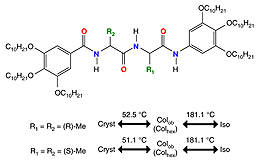ジペプチド誘導体の電場応答性カラムナー相における極性とキラリティーとの相互作用
Interplay between polarity and chirality in the electric-field-responsive columnar phase of a dipeptide derivative.
2012年4月13日 NPG Asia Materials 4, e12 (2012) doi:10.1038/am.2012.20
カラムナー液晶:ペプチドの有望な特性

東京工業大学の竹添秀男教授率いる研究チームによって、ペプチド誘導体の異常な電気光学挙動が報告された。生体分子とその特性を研究することは、生物系をより深く理解するためばかりでなく、特定の目的で生体機能模倣材料を設計する際に重要となる。一部のポリペプチド誘導体は液晶カラムを形成できることで知られているが、研究チームはこのたび、そうしたジペプチド系分子の研究により、二次元に配列した非常に大きいカラムドメインの形成に成功したほか、慎重に選択した外部電場の下でカラムが長軸を中心に回転することも見いだした。ここでの回転の角度と方向は、電場の強度と方向に依存する。この現象は光学特性の変化を伴い、研究者らの提示どおり、カラム内での極性とキラリティーの相互作用を通して起こっている。
Columnar liquid crystals: Promising peptide properties
Hideo Takezoe and colleagues have described an unusual electro-optical behaviour of peptide derivatives. Studying biomolecules and their properties is important in order to gain better understanding of biosystems, as well as in the design of biomimetic materials for specific purposes. Some polypeptide derivatives are known to have the ability to form liquid crystalline columns. Studying such a dipeptide-based molecule, Takezoe and co-workers succeeded in forming a very large domain of columns ordered in two dimensions and observed that, under an external electric field judiciously chosen, the columns rotate around their long axis. Moreover, the angle and direction of the rotation depend on the strength and direction of the field. The phenomenon is accompanied by a change in optical properties and arises, as the researchers propose, through an interplay between polarity and chirality within the columns.

